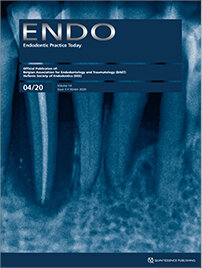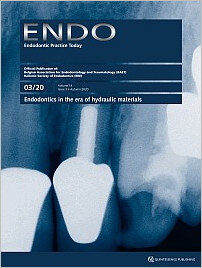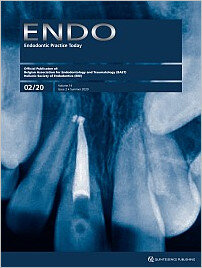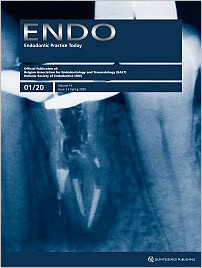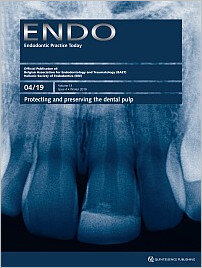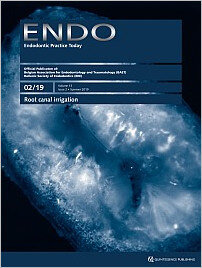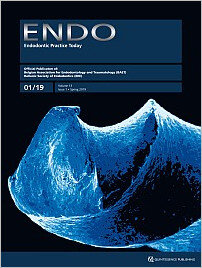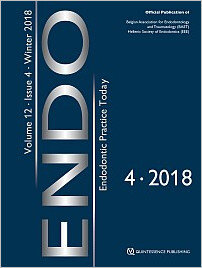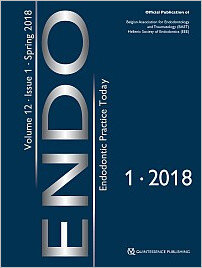Seiten: 247, Sprache: EnglischSchäfer, Edgar / Chong, Bun SanSeiten: 251-262, Sprache: EnglischHarrison, TrisAim: Many factors can affect the cyclic fatigue resistance of nickel-titanium files. Nickel-titanium can exist in a soft martensitic state, which improves its cyclic fatigue resistance. The alloy transforms from the austenite to martensite state at a certain temperature, and various factors can modify this transition temperature. Temperature affects the state of the metal; therefore, the way the file behaves at intracanal temperature is significant. The present review aims to gather evidence to show that martensitic files display increased cyclic fatigue resistance compared to conventional files.
Materials and methods: A population, intervention, comparison, outcomes and study framework was used to formulate the review question and develop the inclusion and exclusion criteria. The search was conducted using the databases Science Direct, Wiley, PubMed and Google Scholar. A single reviewer screened the results, applying the inclusion and exclusion criteria. The results were analysed. The Joanna Briggs Institute Checklist for Cohort Studies was used to assess the quality of the studies. The primary studies and review process were assessed for bias.
Results: A total of 642 studies were screened and 22 studies were included. The overall quality of the included studies was judged as moderate.
Conclusions: Within the limitations of this study, it was found that the Hyflex EDM file (Coltène/ Whaledent, Altstätten, Switzerland) is martensitic at intracanal temperature and has higher cyclic fatigue resistance than the other martensitic phase files.
Schlagwörter: blue files, cyclic fatigue, EDM files, gold files, intracanal temperature, martensitic
Seiten: 263-271, Sprache: EnglischLejri, Walid / Marouane, OmarAn effective irrigant delivery system is mandatory for successful endodontic treatment. The endodontic delivery systems developed in recent years rely on various mechanisms and philosophies for cleaning root canal systems. In general, newer endodontic delivery systems lead to improved canal cleanliness in comparison with conventional syringe needle irrigation. Despite the existence of numerous studies aiming to assess these systems, there are currently no evidence-based studies available to correlate their clinical efficacy. As in daily practice, ergonomics is a crucial factor when choosing an endodontic delivery system; it is necessary to determine how these devices are perceived in terms of practicality and ease of use. The present study provides an overview of the endodontic delivery systems currently available. Based on a new ergonomic index, endodontic delivery systems were assessed in terms of volume, working principle and practicality. While effectiveness in cleaning and disinfecting the root canal system is an aspect to consider when selecting a proper irrigation system, this new ergonomic index may help clinicians to select the appropriate endodontic delivery system.
Schlagwörter: agitation, ergonomics, irrigation, machine-assisted, manual
Seiten: 273-279, Sprache: EnglischKazemipoor, Maryam / Rafei, Kamal / Farahat, FarnazAim: Dental bleaching could adversely affect dentine hardness. The aim of the present study was to evaluate the effect of cervical dentine thickness on hardness reduction of outer dentine following intracoronal bleaching.
Materials and methods: Thirty-six intact anterior teeth were selected and the root segments were separated 2 mm below the cementoenamel junction. Using a diamond fissure bar, dentine substrate was removed so that cervical dentine thickness in one part of the separated tooth was twice that in the other half. A resin-modified glass-ionomer cement plug was placed in 2-mm thickness from the apical side. Teeth were randomly divided into three groups (n = 12) to be treated with bleaching agents containing 35% hydrogen peroxide, sodium perborate, and distilled water in the control group. Vickers hardness numbers were measured for outer and inner dentine in each tooth sample. Data were analysed using Mann-Whitney U tests.
Results: The mean Vickers hardness number between the two dentine thicknesses showed a statistically significant difference only in the sodium perborate bleaching group (P = 0.000). The mean Vickers hardness number of inner dentine was significantly higher in the small dentine thickness in comparison to the large dentine thickness (P = 0.000). The mean Vickers hardness number of outer dentine was significantly higher in the large dentine thickness in comparison to the small dentine thickness (P = 0.000).
Conclusions: Within the limitations of this laboratory study, even in the presence of an orifice barrier, removal of excessive dentine from the root canal walls during root canal preparation could increase the damaging effect of bleaching materials on outer dentine microhardness.
Schlagwörter: hardness test, hydrogen peroxide, sodium perborate, tooth bleaching
Seiten: 281-286, Sprache: EnglischBag, Irem / Kurnaz, Safa / Gülbandılar, AyselAim: The aim of this study was to evaluate the number of bacteria extruded from the tooth apex after root canal instrumentation using three nickel-titanium rotary systems.
Materials and methods: A total of 55 mandibular premolars were extirpated and inserted into glass bottles. The root canals were contaminated with Enterococcus faecalis. The teeth were divided into four groups: ProTaper Universal, ProTaper Next, ProTaper Gold (all Dentsply Sirona, Charlotte, NC, USA) and the control group. For the first three groups, comprised of 15 teeth each, preparation was implemented with ProTaper Universal, ProTaper Next and ProTaper Gold files, respectively. No instrumentation was performed in the control group, comprised of 10 teeth. The solution in the bottles was investigated using the classical bacteria-counting technique. Data were analysed using a Kruskal-Wallis one-way analysis of variance and Mann-Whitney U tests.
Results: The mean number of colony-forming units in the ProTaper Universal and ProTaper Gold groups was significantly higher than in the ProTaper Next group (P < 0.05). The difference between the ProTaper Universal and ProTaper Gold groups was not statistically significant (P > 0.05).
Conclusions: All instrumentation techniques caused extrusion of intracanal bacteria. The ProTaper Universal and ProTaper Gold groups produced significantly more bacterial extrusion than the ProTaper Next group.
Schlagwörter: apical extrusion, ProTaper Gold, ProTaper Next, ProTaper Universal, root canal preparation
Seiten: 289-295, Sprache: EnglischBlauhut, Thorsten / Sonntag, DavidAim: This study aimed to investigate whether a conservative endodontic access cavity design results in an identical assessment of the number and shape of root canals compared to a traditional endodontic access cavity design.
Materials and methods: A total of 84 extracted human molars were examined by 28 students studying for a master’s degree in endodontics, with each student examining three molars. The students were divided into pairs. A conservative endodontic access cavity was prepared in each molar, and the teeth were evaluated independently by both students in the pair to determine the number and shape of the canal orifices. The access cavity was then extended to a traditional endodontic access cavity and independently evaluated again by the same persons. The data were then statistically evaluated using a Wilcoxon signed rank test, chi-square test and McNemar test with the level of significance set at P < 0.05.
Results: For 30 teeth (35.7% total; 37.9% maxillary, 30.8% mandibular), the number of canals detected varied between conservative and traditional endodontic access cavities (P < 0.001). For 152 canals (28.5% total; 26.6% maxillary, 33.6% mandibular), the evaluation of the canal geometry changed (P < 0.001). There were no significant differences in absolute value between the two types of access in terms of the number of canals and the round geometry of the canal orifices, although more oval canals were detected with traditional endodontic access cavities. No absolute difference was found in detected second mesiobuccal root canals in maxillary molars or in the middle mesial canal in mandibular molars.
Conclusion: The conservative endodontic access cavity approach is more susceptible to misinterpretation of the number and shape of canal orifices than the traditional approach.
Schlagwörter: minimally invasive, orifice assessment, reliability, root canal detection, traditional access
Seiten: 297-304, Sprache: EnglischMankabadi, Sarah Isaac El / Ahmed, Geraldine Mohamed / ElAsfouri, Heba AhmedAim: To compare the cyclic fatigue resistance of three thermomechanically treated rotary nickeltitanium instruments, 2Shape (TS; Micro-Mega, Besancon, France), ProTaper Gold (PTG; Dentsply Maillefer, Baillagues, Switzerland) and Vortex Blue (VB; Dentsply Tulsa Dental Specialties, Tulsa, OK, USA), under intracanal conditions.
Materials and methods: A total of 36 rotary nickel-titanium instruments of (12 TS [25/0.06]; 12 PTG [25/0.08]; 12 VB [25/0.06]) were rotated in a custom-made model with a 60-degree angle of curvature and 5-mm radius of curvature until fracture occurred. The model was immersed in an acrylic resin container filled with 2.5% sodium hypochlorite (NaOCl) solution set at intracanal temperature (35°C ± 2°C). Time to fracture was recorded, then the number of cycles to failure was calculated. The length of the fractured segments was measured using a digital caliper and scanning electron microscopy was also performed. The data were statistically analysed using a Kruskal-Wallis and Dunn test with the significance level set at P ≤ 0.05.
Results: The PTG group showed the highest statistically significant number of cycles to failure followed by the VB and TS groups, respectively (P ≤ 0.001). Both the PTG and TS groups exhibited no statistically significant difference regarding the length of the fractured segments (P ≥ 0.05); however, they had statistically significant longer fragments compared to the VB group (P ≤ 0.007). Scanning electron microscopy analysis revealed typical features of cyclic fatigue failure.
Conclusions: The PTG system had the highest cyclic fatigue resistance followed by the VB system. The T-wire technology of the TS system showed the lowest resistance to cyclic fatigue.
Schlagwörter: 2Shape, cyclic fatigue, intracanal environment, ProTaper Gold, thermomechanical treatment, Vortex Blue
Seiten: 305-315, Sprache: EnglischJoshi, Raina Mahesh / Kapoor, SonaliAim: Tri Auto ZX2 (Morita, Saitama, Japan), an endodontic motor with an inbuilt apex locator, claims to offer the new feature of monitoring canal length in real time to facilitate working length control during root canal preparation. As such, the present study aimed to evaluate its applicability and features in clinical settings, especially in curved canals as these tend to straighten during preparation, leading to iatrogenic errors and postoperative pain and requiring continuous monitoring of working length. This study also aimed to determine the impact of simultaneous working length determination on postoperative pain in curved canals.
Materials and methods: Sixty patients with mandibular molars with curved canals as per the eligibility criteria were randomly divided into two groups: Group 1, the control group (separate working length determination and root canal preparation, n = 29), and Group 2, the intervention group (simultaneous working length determination during root canal preparation, n = 31). Single-sitting root canal treatment was performed using Tri Auto ZX2. Patients’ age, sex, tooth number, root canal curvature, preoperative and postoperative pain assessed on the Heft-Parker visual analogue scale and analgesic intake were recorded. The data were analysed using a chisquare test, independent-samples t test and paired t test.
Results: There was a significant reduction in postoperative pain in Group 2 on days 1, 5 and 7 (P < 0.05). Group 2 showed a significant reduction in postoperative pain irrespective of canal curvature as compared to Group 1, with a significant difference in moderately curved canals (P < 0.05). Only two patients from Group 2 required analgesics, whereas nine patients required them in Group 1.
Conclusion: Working length determination during root canal preparation provides real-time canal measurement and kinematic features that help to reduce postoperative pain. The new feature of Tri Auto ZX2 can be clinically applied for single-sitting root canal treatment irrespective of canal curvature and severity of preoperative pain.
Schlagwörter: curved root canals, endodontic motor, inbuilt apex locator, postoperative pain, simultaneous working length determination, Tri Auto ZX2
Seiten: 317-324, Sprache: EnglischPietrzycka, Krystyna / Pawlicka, HalinaAim: Endodontic-periodontal disease is difficult to treat. The difficulty is related to establishing which component of the inflammation is of endodontic origin and which is periodontal. It is therefore crucial to reveal the origin of endodontic-periodontal disease before initialising root canal treatment. It is important to realise that if the root canal treatment will lead to a severe periodontal condition, the necessary efforts to save the tooth will be ccomplex and expensive and the outcome will be uncertain. This article describes the cases of two patients diagnosed with endodontic-periodontal lesions.
Materials and methods: Two teeth with different types of endodontic-periodontal lesions were treated and followed up. The first was a type II endodontic-periodontal lesion (according to Messing and Stock’s classification) and the second was a type IV lesion. In case 1, root canal treatment was carried out over two visits with calcium hydroxide as an intracanal dressing, and in case 2, the appropriate treatment was provided for a type IV lesion.
Results: In case 1, complete healing was observed after root canal treatment. In case 2, progressive bone reconstruction was visible around the treated tooth after 1 year of observation. The following year, a decision was made to extract the tooth due to the patient’s lack of cooperation with the dental practitioner.
Conclusion: It is important to properly diagnose and reveal the origin of endodontic-periodontal disease before initialising root canal treatment, but the patient’s cooperation with the dental practitioner is also crucial, and can contribute to successful treatment outcomes.
Schlagwörter: endodontic-periodontal disease, endodontic-periodontal lesions, periodontal abscess, root canal treatment
Seiten: 327-333, Sprache: EnglischDhesi, Manpreet / Chong, Bun SanThe advent of guided endodontics, combining 3D imaging techniques with digitally designed guides, has led to its utilisation in surgical and nonsurgical root canal treatment. To date, however, guided endodontics has focused mainly on static guidance, with dynamic guidance receiving limited attention. In the present case report, a dynamic navigation implant system was used for guided endodontics. The safe and accurate access cavity preparation, location and negotiation of tahe calcified canals of a maxillary second premolar demonstrate the successful clinical application of dynamic guided endodontics in everyday endodontic practice.
Schlagwörter: access cavity, canal location, dynamic navigation, guided endodontics
Seiten: 335-342, Sprache: EnglischRadwański, MateuszAim: The aim of the present case series was to present three methods of conservative instrument fragment removal.
Materials and methods: Different removal techniques were applied; ultrasonic tips, injection needles, small-size hand files and a dental operating microscope were used. Ultrasonic tips were used for the removal of stainless steel files. In one of the cases, removal occurred after loosening the fragment and activating the rinsing solution (citric acid). In another, due to the earlier separation and shortening of the removed fragment using ultrasonics, an injection needle and dental cement were employed. For nickel-titanium rotary file removal, the access to and exposure of the coronal fragment were achieved using an injection needle mounted on an endomotor, then the file was removed using cement and an injection needle.
Results: In all three cases, the instrument fragments were removed successfully. The success of removal could be influenced by the length of the broken part of the file or the lack of extrusion into the periapical tissues.
Conclusions: The file removal procedure is complicated. It requires an experienced operator, specialised equipment and knowledge of treatment and management protocols depending on the treatment case.
Schlagwörter: fractured, instrument removal, management, root canal instruments, separated





